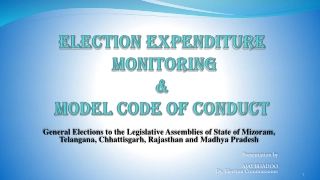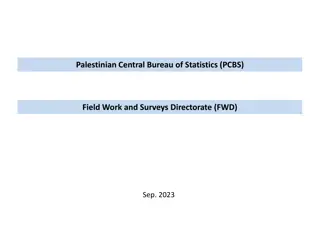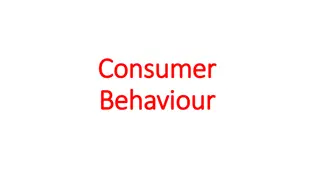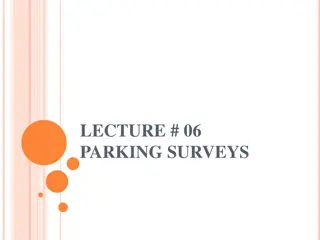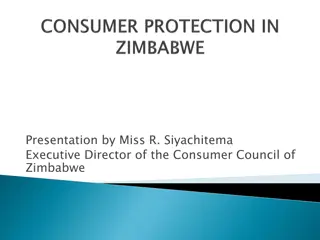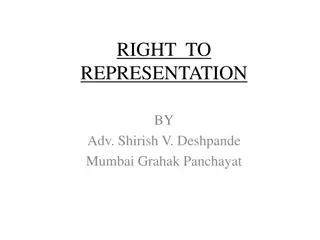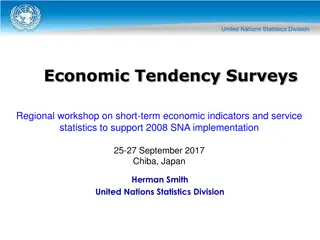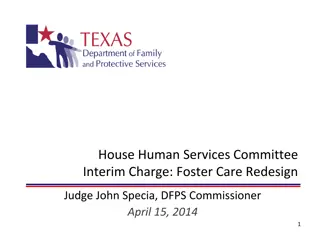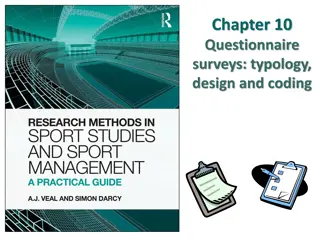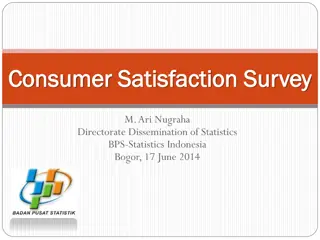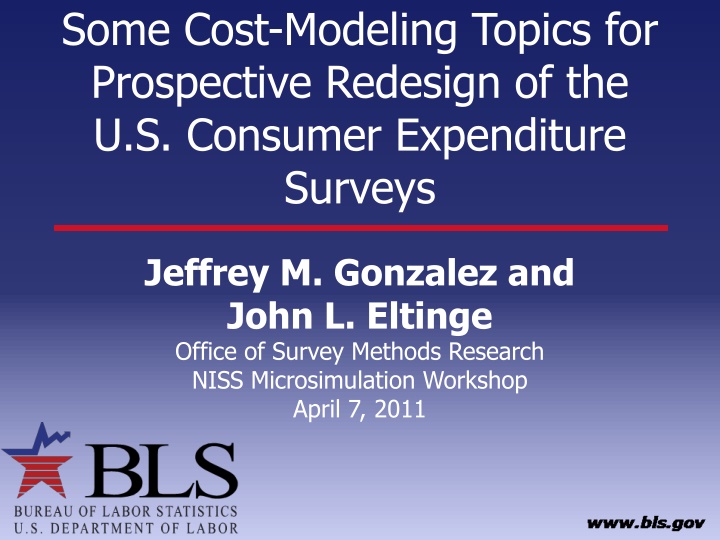
Prospective Redesign of U.S. Consumer Expenditure Surveys
Cost modeling topics and considerations for the redesign of the U.S. Consumer Expenditure Surveys, focusing on improving data quality and addressing under-reporting issues through responsive designs and the use of administrative records. The mission, challenges, timeline, and primary methodological question of the survey redesign project are outlined.
Download Presentation

Please find below an Image/Link to download the presentation.
The content on the website is provided AS IS for your information and personal use only. It may not be sold, licensed, or shared on other websites without obtaining consent from the author. If you encounter any issues during the download, it is possible that the publisher has removed the file from their server.
You are allowed to download the files provided on this website for personal or commercial use, subject to the condition that they are used lawfully. All files are the property of their respective owners.
The content on the website is provided AS IS for your information and personal use only. It may not be sold, licensed, or shared on other websites without obtaining consent from the author.
E N D
Presentation Transcript
Some Cost-Modeling Topics for Prospective Redesign of the U.S. Consumer Expenditure Surveys Jeffrey M. Gonzalez and John L. Eltinge Office of Survey Methods Research NISS Microsimulation Workshop April 7, 2011
Disclaimer The views expressed here are those of the authors and do not necessarily reflect the policies of the U.S. Bureau of Labor Statistics, nor of the FCSM Subcommittee on Statistical Uses of Administrative Records. 2
Outline Background Consumer Expenditure Surveys (CE) and redesign Conceptual information Redesign options Responsive partitioned designs Use of administrative records Prospective evaluation using microsimulation methods Additional considerations 3
Mission statement The mission of the CE is to collect, produce, and disseminate information that presents a statistical picture of consumer spending for the Consumer Price Index (CPI), government agencies, and private data users. 5
The Gemini Project Rationale for survey redesign Challenges in social, consumer, and data collection environments Mission of Gemini Redesign CE to improve data quality through verifiable reduction in measurement error, focusing on under- reporting Cost issues also important 6
Timeline for redesign 2009 11: Hold research events, produce reports 2012: Assess user impact of design alternatives, recommend survey redesign, propose transition roadmap 2013+: Piloting, evaluation, transition 7
Primary methodological question For a specified resource base, can we improve the balance of quality/cost/risk in the CE through the use of, for example Responsive partitioned designs Administrative records 8
Evaluation With changes in the quality/cost/risk profile, must distinguish between Incremental changes (e.g., modified selection probabilities, reduction in number of callbacks) Fundamental changes (partitioned design, new technologies, reliance on external data sources) 9
Potential redesign options New design possibilities Semi-structured interviewing Partitioned designs Global questions Use of administrative records New data collection technologies Financial software PDAs, smart phones 11
Partitioned designs Extension of multiple matrix sampling, also known as a split questionnaire (SQ) Raghunathan and Grizzle (1995); Thomas et al. (2005) Involve dividing questionnaire into subsets of survey items, possibly overlapping, and administering subsets to subsamples of full sample Common examples: TPOPS, Census long-form, Educational testing 12
Methods for forming subsets Random allocation Item stratification (frequency of purchase, expenditure category) Correlation based Tailored to individual sample unit 13
Graphic illustrating SQ designs 14
Potential deficiency of current methods 1. Heterogeneous target population 2. Surveys inquiring about rare events and other complex behaviors 3. Incomplete use of prior information about sample unit 15
Responsive survey design Actively making mid-course decisions and survey design changes based on accumulating process and survey data Double sampling, two-phase designs Decisions are intended to improve the error and cost properties of the resulting statistics 16
Components of a responsive design 1. Identify survey design features potentially affecting the cost and error structures of survey statistics 2. Identify indicators of cost and error structures of those features 3. Monitor indicators during initial phase of data collection 17
Components of a responsive design (2) 4. Based on decision rule, actively change survey design features in subsequent phases 5. Combine data from distinct phases to produce single estimator 18
Illustration of a three-phase responsive design (from Groves and Heeringa [2006]) 19
Examples of administrative records 1. Sales data from retailers, other sources Aggregated across customers, by item Possible basis for imputation of missing items or disaggregation of global reports 2. Collection of some data (with permission) through administrative records (e.g., grocery loyalty cards) linked with sample units 21
Evaluation of administrative record sources 1. Prospective estimands a. Population aggregates (means, totals) b. Variable relationships (regression, GLM) c. Cross-sectional and temporal stability of (a), (b) 2. Integration of sample and administrative record data Multiple sources of variability 22
Cost structures Costs likely to include a. Obtaining data (provider costs, agency personnel) b. Edit, review, and management of microdata c. Modification and maintenance of production systems 1. Each component in (1) will likely include high fixed cost factors, as well as variable factors 2. Account for variability in costs and resource base over multiple years 3. 23
Methodological and operational risks Distinguish between 1. Incremental risks, per standard statistical methodology 2. Systemic risks, per literature on complex and tightly coupled systems Perrow (1984, 1999); Alexander et al. (2009); Harrald et al. (1998); Johnson (2002); Johnson (2005); Leveson et al. (2009); Little (2005) 24
PROSPECTIVE EVALUATION USING MICROSIMULATION METHODS 25
Microsimulation modeling Primary goal Describe events and outcomes at the person-level Main components (Rutter, et al., 2010) 1. Natural history model 2. Intervention model 26
Application to redesign 1. Understanding, identification of distinct states of underlying behavior (e.g., purchase) and associated characteristics (e.g., amount) 2. Effect of intervention (i.e., redesign option) on capturing (1) 27
Natural history model Household demographics Substitution Motivation Consumer Behavior Brand preference Lifestyle New product introduction
Developing the natural history model Identify fixed number of distinct states and associated characteristics Specify transition probabilities between states Set values for model parameters 29
Intervention model Redesign option Statistical products Consumer behavior Survey 30
Intervention model (2) Attempting to model unknown fixed/random effects Input on cost/error components from field staff and paradata Insights from lab studies, field tests, other survey experiences 31
Examples of intervention model inputs Partitioned designs Likelihood of commitment from field staff Cognitive demand on respondents (e.g., recall/context effects) Administrative records Availability Linkage Respondent consent 32
ADDITIONAL CONSIDERATIONS
Discussion 1. Data needs for model inputs, parameters Subject matter experts Users 2. Model validation and sensitivity analyses Parameter omission Errors in information 34
Discussion (2) 3. Effects of ignoring statistical products, stakeholders Full family spending profile CPI cost weights 4. Dimensions of data quality Total Survey Error Total Quality Management (e.g., relevance, timeliness) 35
References Alexander, R., Hall-May, M., Despotou, G., and Kelly, T. (2009). Toward Using Simulation to Evaluation Safety Policy for Systems of Systems. Lecture Notes in Computer Science (LNCS) 4324. Berlin: Springer. Gonzalez, J. M. and Eltinge, J. L. (2007). Multiple Matrix Sampling: A Review. Proceedings of the Section on Survey Research Methods, American Statistical Association, 3069 75. Groves, R. M. and Heeringa, S. G. (2006). Responsive Design for Household Surveys: Tools for Actively Controlling Survey Errors and Costs. Journal of the Royal Statistical Society, Series A, 169(3), 439 57. Harrald, J. R., Mazzuchi, T. A., Spahn, J., Van Dorp, R. , Merrick, J., Shrestha, S., and Grabiwski, M. (1998). Using System Simulation to Model the Impact of Human Error in a Maritime System. Safety Science 30, 235 47. Johnson, C. (ed.) (2002). Workshop on the Investigation and Reporting of Incidents and Accidents (IRIA 2002). GIST Technical Report G2002-2, Department of Computing Science, University of Glasgow, Scotland. 36
References (2) Johnson, David E. A. (2005). Dynamic Hazard Assessment: Using Agent-Based Modeling of Complex, Dynamic Hazards for Hazard Assessment. Unpublished Ph.D. dissertation, University of Pittsburg Graduate School of Public and International Affairs. Leveson, N., Dulac, N., Marais, K., and Carroll, J. (2009). Moving Beyond Normal Accidents and High Reliability Organizations: A Systems Approach to Safety in Complex Systems. Organizational Safety, 30, 227 49. Little, R.G. (2005). Organizational Culture and the Performance of Critical Infrastructure: Modeling and Simulation in Socio-Technological Systems. Proceedings of the 38th Hawaii International Conference on Systems Sciences. Rutter, C. M., Zaslavsky, A. M., Feuer, E. J. (2010). Dynamic Microsimulation Models for Health Outcomes: A Review. Medical Decision Making, Sage Publication, 10 8. Raghunathan, T. E. and Grizzle, J. E. (1995). A Split Questionnaire Survey Design. Journal of the American Statistical Association, 90, 54 63. Thomas, N., Raghunathan, T. E., Schenker, N., Katzoff, M. J., and Johnson, C. L. (2006). An Evaluation of Matrix Sampling Methods Using Data from the National Health and Nutrition Examination Survey. Survey Methodology, 32, 217 31. 37
Contact Information Jeffrey M. Gonzalez gonzalez.jeffrey@bls.gov John L. Eltinge eltinge.john@bls.gov Office of Survey Methods Research www.bls.gov/ore

